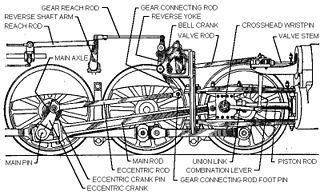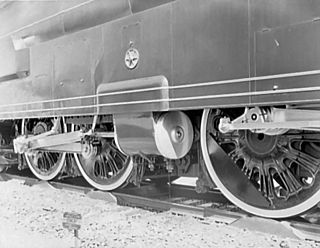
A tank locomotive or tank engine is a steam locomotive that carries its water in one or more on-board water tanks, instead of a more traditional tender. Most tank engines also have bunkers to hold fuel; in a tender-tank locomotive a tender holds some or all of the fuel, and may hold some water also.

The valve gear of a steam engine is the mechanism that operates the inlet and exhaust valves to admit steam into the cylinder and allow exhaust steam to escape, respectively, at the correct points in the cycle. It can also serve as a reversing gear. It is sometimes referred to as the "motion".

The Chasewater Railway is a former colliery railway running round the shores of Chasewater in Staffordshire, England. It is now operated as a heritage railway.

The Walschaerts valve gear is a type of valve gear invented by Belgian railway mechanical engineer Egide Walschaerts in 1844 used to regulate the flow of steam to the pistons in steam engines. The gear is sometimes named without the final "s", since it was incorrectly patented under that name. It was extensively used in steam locomotives from the late 19th century until the end of the steam era.

The GWR 4100 Class was a class of steam locomotives in the Great Western Railway (GWR) of the United Kingdom.

The London Midland and Scottish Railway (LMS) Hughes Crab or Horwich Mogul is a class of mixed traffic 2-6-0 steam locomotive built between 1926 and 1932. They are noted for their appearance with large steeply-angled cylinders to accommodate a restricted loading gauge.

After about 1910 Baker valve gear was the main competitor to Walschaerts valve gear for steam locomotives in the United States. Strictly speaking it was not a valve gear but a variable expansion mechanism adapted to the Walschaerts layout replacing the expansion link and sliding die block. The Baker arrangement used more pivot bearings or pin joints, but avoided the die slip inherent to the expansion link, with the aim of lessening wear and the need for service; it could also facilitate longer valve travel.

The Stephenson valve gear or Stephenson link or shifting link is a simple design of valve gear that was widely used throughout the world for various kinds of steam engines. It is named after Robert Stephenson but was invented by his employees.

W. G. Bagnall was a locomotive manufacturer from Stafford, England which was founded in 1875 and operated until it was taken over in 1962 by English Electric.

The NZR A class were a class of steam locomotives built in 1906 with a 4-6-2 wheel arrangement for the New Zealand Railways Department (NZR). The class should not be confused with the older and more obscure A class of 1873. They were designed by the NZR's Chief Mechanical Engineer, A. L. Beattie and his Chief Draughtsman, G. A. Pearson to replace less powerful locomotives struggling with increasing loads on the South Island Main Trunk Railway, and in anticipation of the traffic volumes that would be created upon the completion of the North Island Main Trunk Railway.

Joy valve gear is a type of steam locomotive valve gear, designed by David Joy, Locomotive and Marine engineer, and patented on 8 March 1879. The British patent has not been found but the US patent has. Joy's gear is similar to Hackworth valve gear but has a compensating mechanism which corrects for "the slight inequality in the motion of the valve arising from the arc of the lever".
Bagnall–Price valve gear is a type of steam engine valve gear developed at locomotive manufacturer W.G. Bagnall as an alternative to the more common Walschaerts valve gear and also to supersede the Baguley valve gear their designs had previously utilised. The gear was patented in 1903 by W.G. Bagnall and T. S. Price, the manager of the works.

Ernest E. Baguley (1863–1948) was a British engineer.

Rishra was built in 1921 by Baguley Cars Ltd. Following a working life in India it is now preserved at the Leighton Buzzard Light Railway, Buckinghamshire, England.

Sea Lion is a steam locomotive built in 1896 to supply the motive power to the Groudle Glen Railway on the Isle of Man and the locomotive still provides the main traction there today. The locomotive was built by W.G. Bagnall & Co., Stafford and delivered to the line in May of that year, providing sole motive power until joined in 1905 by sister locomotive Polar Bear. When delivered to the railway, the locomotive carried an olive green livery with vermilion and yellow lining and the name carried on the side water tank in gold leaf with blue shadowing, with distinctive round "spectacle" cab windows back and front. These were changed over to rectangular windows very early in the engine's career to improve driver visibility however. One distinctive feature was a displacement lubricator mounted atop the highly polished brass dome. The locomotive was fitted with unusual valve gear patented by E.E. Baguley and is one of only four locomotives to remain in existence with this. By the 1920 season the locomotive was deemed too costly for repair and the line purchased two battery electric locomotives that inherited their steam engine names. The modern engines proved to be financially disastrous and within a few years "Sea Lion" had been returned to the works for re-build. It continued to operate the line until closure at the outbreak of the Second World War in 1939.

A duplex locomotive is a steam locomotive that divides the driving force on its wheels by using two pairs of cylinders rigidly mounted to a single locomotive frame; it is not an articulated locomotive. The concept was first used in France in 1863, but was particularly developed in the early 1930s by the Baldwin Locomotive Works, the largest commercial builder of steam locomotives in North America, under the supervision of its then chief engineer, Ralph P. Johnson.

The South African Railways Class 10A 4-6-2 of 1910 was a steam locomotive from the pre-Union era in Transvaal.
On a steam locomotive, the reversing gear is used to control the direction of travel of the locomotive. It also adjusts the cutoff of the steam locomotive.

The W. G. Bagnall New Standard 180-6-0ST is a type of industrial steam locomotive manufactured at W. G. Bagnall's Castle Engine Works and designed by Harold Wood at W.G. Bagnall in 1951. The class was specifically designed for the Port Talbot Steelworks, and ran from 1951 to 1973 in industrial service. Two locomotives, the former Longbridge locomotives, are preserved.
The Cape Government Railways 4th Class 4-6-0TT of 1882 with Joy valve gear, was a South African steam locomotive from the pre-Union era in the Cape of Good Hope.
















